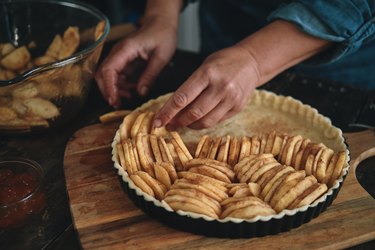
There's more than one way to make apple pie. Of course, you could take the shortcut and just add raw apples to a pie crust and bake, but if you want a blue ribbon-worthy dessert, the secret happens before the pie goes in the oven.
Registered dietitian and chef Julie Andrews, RDN, CD, gave us the inside scoop on the best way to make apple pie filling.
Video of the Day
Video of the Day
Why You Should Cook Apples First
It Yields a Sturdier Pie
No one wants a weak pie that crumbles the second you fork into it. Cooking your apples first can help with the sturdiness.
"Adding raw apple filling to the pie generally results in a pie with a gap between the top layer of crust and the filling," Andrews says. "When the apples are cooked, they won't lose much volume once they're inside the pie dough, so the gap is generally avoided."
This is because you need to cook some of the water out of the apples and soften them. This means they have already had the opportunity to cook down, lessening the change of an air-filled pie.
More Flavor
You might just get more flavor in your pie by cooking the apples prior to baking. Sautéing the apples first will add a deep, rich flavor, which Andrews says is what happens with most fruit.
"Caramelizing the apples will bring out more natural sweetness and more flavor, and adding the spices while cooking the apples will bring out more of their flavor," Andrews tells LIVESTRONG.com.
You'll Use Less Sugar
"From a nutrition perspective, sautéing or roasting the apples first will allow for a sweeter flavor, so you may even be able to add less sugar without sacrificing flavor," Andrews adds, pulling from her background as a registered dietitian.
You might find that using a variety of apples in your pie also helps add a depth of sweetness that you won't get from simply adding more sugar. Andrews like a combination of honey crisp, granny smith, galas or pink lady because of they hold up well and won't yield a mushy pie.
When you cook your filling first, it gives you the opportunity to start with less sugar and then add more sweetness as needed, instead of adding it all at once and hoping for a delicious outcome.
It's Quicker
If you've ever opened a can of apple pie filling, you know it's a real time-saver when it comes to making apple pie.
Cooking your own apple pie filling at home is simple and inexpensive, and the filling will keep in the fridge for a few days. That means you can make it 2 to 3 days in advance and it will be ready when the pie-making commences.
How to Make Apple Pie Filling at Home
Below, find Andrews' best recipe for apple pie filling, plus what she uses to bring out the flavor for the best-tasting pie.
Things You'll Need
Cutting board
Paring knife
Measuring spoons
Pie pan
Variety of apples
Unsalted butter
Dark brown sugar
Pure vanilla extract
Spices: Cinnamon, nutmeg, cloves
Cornstarch
Lemon juice
Salt
Pie crust
1. Peel and Slice the Apples
This is typically the first step in making apple pie filling, however, it's a matter of preference. Andrews notes, "I skip this step because it's a hassle and I enjoy the fiber and texture the skin adds to the pie. But if you prefer to peel them, go ahead and do so!"
Peel-on or peel-off, the next step is to slice the apples evenly. Stick to 1/4 to 1/2 inch thick when slicing. You could also dice your apples if you prefer — it's your pie, do what feels right.
2. Sauté in a Skillet With Sugar and Butter
In a skillet that's large enough to hold all of your apples, Andrews adds just enough melted butter to cover the bottom. For sweetness, she prefers dark brown sugar, "because it has a richer molasses flavor." That way, you can use less sugar without sacrificing flavor.
"in general, I use half of the sugar that typical pie fillings call for because I want the spices and apples to shine and not be overly sweet," Andrews says.
3. Add Spices
This is where the personalization of your pie begins. Andrews typically adds a combination of pure vanilla extract, cinnamon and a pinch of ground nutmeg and cloves.
"I generally double the amount of cinnamon most recipes use and use a few tablespoons of freshly squeezed lemon juice as the liquid to bring together the filling — it provides a bright and fresh flavor," Andrews says. "I use a few tablespoons of cornstarch mixed with the lemon juice to thicken the filling."
Then, add your salt: "It enhances the flavor of the filling."
4. Finish Your Pie
Depending on the final destination of your apple pie filling, this step will look different for everyone. Here are some options on how to use your apple pie filling:
- Classic apple pie with a bottom and top crust
- Dutch apple pie with a crumble crust
- Apple pie filling for topping for oatmeal or yogurt
- Apple pie bars